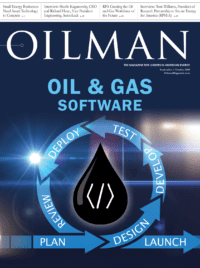The latest trend in digital transformation is leveraging RPA (Robotic Process Automation) to automate between 30 to 45 percent of manual work. There are ever increasing reports of organizations using RPA to accelerate execution of tedious, monotonous tasks in finance and accounting, human resources, recruiting, supply chain and other oil and gas functions. There is mounting evidence that organizations that implement RPA can achieve a 40 percent average reduction in processing time and a 50 percent average reduction in costs. RPA implementation is enabling improved accuracy, increased reliability, and strengthened controls. It appears that RPA is helping combat skilled labor shortages in data management and analytics positions, by creating easier and more efficient access to operational data and real-time information.
While RPA has been leveraged more in the back-office space, there are big opportunities within oil and gas operations, such as joint venture (JV) and revenue accounting, drilling and completions, production engineering, field operations, subsurface, and operational data management.
Joint Venture Accounting and Revenue and JIB Netting
Those oil and gas companies that use RPA to automate their monthly close process have experienced 30-50 percent improvement in closing times. The expectation is that JV accounting and revenue and JIB netting processes could benefit from leveraging RPA, as well. The necessary levels of IT integration between the various internal and external systems is challenging to implement and maintain. If the systems cannot be integrated, then considerable man hours are spent transferring data from one system to another. RPA can be used, in a non-invasive way, to create a bridge between the various systems. RPA can also automate high volumes of adds, changes, and deletions to the accounts. Lastly, RPA bots can be used to mitigate staff shortages, build expert knowledge into processes, and free up resources to work on activities that add more value.
Drilling and Completions
As oil and gas teams are drilling wells, they must compile and analyze data from multiple sources to ensure they’re drilling in the right direction at the right costs. If the team is heading in the wrong direction, it must be identified quickly. RPA can provide valuable support for operational reporting and drilling performance by automatically pulling data from systems, such as WellView, to help in the analysis process. RPA can also pull vendor well data, purchase order data, costs, and forecast data into a data warehouse to be used for more comprehensive analytics. Drilling engineers can use RPA to look at data and see differences between processes across rigs. This creates substantial time savings and streamlining, which can result in significant financial improvements over the year.
Work Over Optimization
A significant amount of human resources is spent identifying in which wells to invest workover time and effort. Typically, the investigation process requires conducting analysis using multiple tools to then compile an evaluation. The end-to-end process requires data to be captured, transformed, and transferred from one system to another – a tedious and burdensome process. So much so, that many teams utilize best guesses to evaluate and make decisions, which doesn’t always translate to pursuit of the best targets. RPA can be used to automate the repetitive activities, which will free up time for resources to conduct value adding evaluations to identify the best workover targets.
Production Engineering
Production teams are in regular need of historical well data that provides a performance story for a well, from beginning to end. To pull together this type of information, team members will spend many hours obtaining information from analytics tools and multiple sources (legacy databases, excel files, engineers’ knowledge, etc.). RPA is built to handle this type of task, as it sits next to existing tools and data sets and mimics the steps humans take to gather information from the disparate sources. An RPA bot can be set to execute hidden commands in the legacy systems to speed up processing. It can also run unattended, 24 hours per day and 7 days per week. The result is an efficient process with superior results.
Field Operations (Field Asset Team)
The team members who are hands-on in the field need access to well information and analytics to be able to safely optimize, operate, and maintain wells and all surface equipment on the lease or facilities. The challenge becomes getting these team members the information they need in a usable format. Having information delivered in an easy to access, user-friendly manner is critical to field operations teams. RPA can be used to gather information from various systems, compile the information into a ranked issues report, and deliver the report to field operations’ team members by email or another report out method. Using RPA will free operations support staff to work on higher value activities.
Subsurface Data Management and Operations Data Analytics
For geoscientists, drilling, operations, and production engineers to conduct data analysis that helps move the needle for the business, they must have data available in a usable format. Subsurface data management and operations data analytics team members are instrumental to making the data available. Unfortunately for many organizations, these team members are in high demand and are stretched to capacity. RPA can expand the capabilities of these team members through automation of data request processing; data capture from legacy systems; data cleanup; data storage in a warehouse; and conducting QA / QC steps on the data to flag potential problems. When there is an increase in project volume or data ingestion, data processing capacity can be expanded to meet the increased demand.
The briefly described ways that RPA can be leveraged by oil and gas operations provides a view of some of the benefits that can be achieved. RPA helps companies do more with the limited resources available. RPA also helps to reduce costs, sometimes by as much as 35-65 percent for onshore process operations, and can improve efficiency by as much as 50-75 percent. In some transaction-heavy applications, the time to process data can be reduced by up to 95 percent. Another known benefit of RPA technology is that it offers an investment recovery period between six to nine months, which has proven to be a major driver for RPA market.
With this in mind, one might wonder if oil and gas companies have time to waste when it comes to implementing RPA. We think not.
Allen Yoho is a management consulting with Enaxis Consulting. Yoho has over 10 years project management experience, as well as an established track record of
leading projects from inception to operation utilizing project management best practices to deliver superior results. Over the past seven years he has worked extensively in the oil and gas industry. Yoho earned a BS of Business Administration in Finance from California State University – Sacramento, as well as an MBA from University of Warwick.







